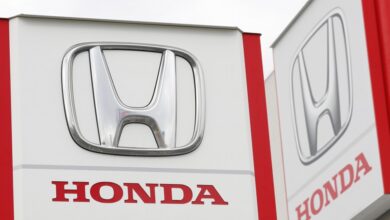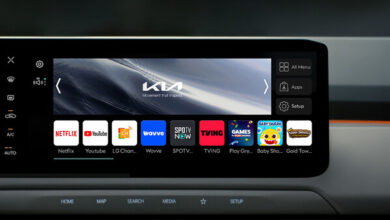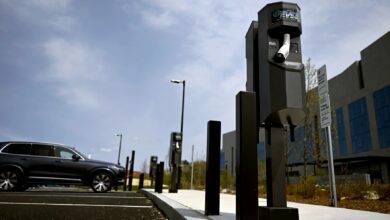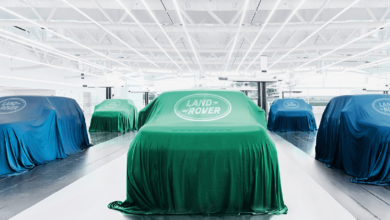Could electric vehicles become the future of Formula 1 car races?
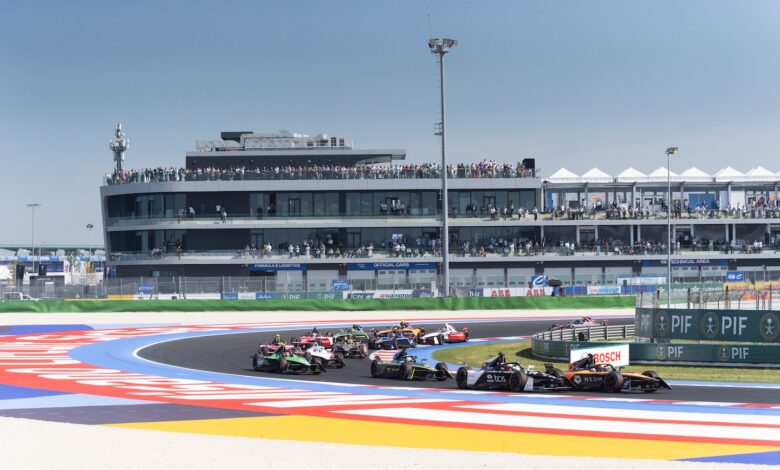
“It’s like whistling,” said Jeroen Bos, a motorsports fan from the Netherlands.
Creating an all-electric motorsport is a bold venture. Formula 1 and NASCAR have built big, entrenched cultures based on the appeal of classic full-throttle power. Even the famed motorsports catchphrase is an ode to combustion: Gentlemen, start your engines.
But Formula E, as the championship is known, is a study in the challenges — and potential — of the electric vehicle transition. In trying to make inroads with the sporting mainstream, Formula E is still figuring out how to market the idea of battery-powered racecars — and whether to play up its similarities to the gasoline age or the parts that are different.
What’s clear, in watching a Formula E race, is that EVs are forcing the motorsports world to adjust.
For spectators, the noise level is only the first of many contrasts. During Formula E races, the scoreboard shows the cars’ energy levels, and a crucial aspect of strategy is based on battery conservation. There are typically no pit stops, because the drivers don’t change tires, for the sake of sustainability. There have been plenty of crashes, just not fiery ones on account of the lack of fuel.
Compared to Formula 1, the races are shorter, and the crowds — in a series that holds 16 annual races on four continents — are smaller. Formula 1 has a celebrated Netflix docuseries that has juiced global interest, especially in the United States; Formula E has a series on YouTube for which most episodes have fewer than 50,000 views.
But many in Formula E say its rise is inevitable. When the series was started 10 years ago, with the explicit goal of accelerating the adoption of EVs, some 300,000 electric vehicles were sold globally. This year, projections put the number at 17 million, and big-name carmakers — Porsche, Jaguar, Nissan — have created Formula E teams, using the racing circuit as an innovation lab for their EV technology. Maserati also helps fund a team for which its parent company, Stellantis, acts as the manufacturer.
“This is the most relevant form of motorsports for the future,” said James Barclay, the racing team director for Jaguar, whose commercial fleet will become all electric next year. “If you look at every single major manufacturer in the world, they’re spending their money on electric vehicles. That’s the reality of the industry. And the pace [at which] the sport transitions will mirror the industry.”
During Formula E’s decade-long span, gains in battery technology have driven the sport. Because of limited range, Formula E drivers used to have to swap cars midrace; now, they no longer do. Car speeds have increased almost 45 percent, hitting 200 miles per hour. That’s still about 30 miles per hour slower than the top speeds of a Formula 1 car. But EV motors are changing faster than gas engines. Antonio Felix da Costa, who drives the No. 13 car for Porsche, said he believes that the fastest kind of racecar will be an EV eventually.
By then, he said, the novelty might be noisy racecars with gas-powered engines.
“Think about somebody born today,” he said. “Like 18 years from now, if they were to hear a V8, they’d think it is disgusting.”
A race designed to inspire innovation
For consumers, EV range anxiety — concern about a car’s ability to go the necessary distance without recharging — is one of the factors tempering all-electric growth. In Formula E, a version of this tension defines every race.
The cars file behind the starting line with only about 60 percent of the energy they need to finish the race. If drivers go full-on, pushing the gas pedal through every turn, their allotted energy quickly peters out. So instead, they play what one driver, Jaguar’s Nick Cassidy, described as the “efficiency game.” They bunch together in a pack to cut down on wind resistance. They focus obsessively on decelerating and braking — measures that in an EV spin the motor in reverse, forcing current back into the battery. A driver’s goal — the prerequisite to winning — is to regenerate power and cross the finish line as the car’s energy ticks down to zero.
The car’s software, which manages the regeneration, can be customized for every turn in a race. One of the biggest factors differentiating Formula E’s 11 teams, each with two drivers, is how they navigate these decisions.
“I’ll show you how it’s done,” da Costa said hours before the sixth race of the year, on Italy’s Adriatic coast.
He led a reporter toward the cockpit of his black and red Porsche, slapped with sponsor logos, and pointed toward a monitor on his steering wheel that can gauge the energy he uses on every lap, along with other data that teams closely guard as proprietary.
“Don’t take a picture of it,” he said with a smile.
He said he receives a series of beeps and buzzes in his headset around every turn, signaling when to lift off the throttle, how significantly to slow down.
Emphasizing range and efficiency is a deliberate focal point of the sport. For every race, Formula E drivers are given energy limits lower than their actual battery capacity; they could race more all-out, if they were allowed to. And even the batteries could grow in capacity by several times, to match commercial EVs, if the sport so wished. The top road EVs can go more than 400 miles without recharging. The race in Italy was a mere 58.8 miles.
But the move to limit energy usage is meant to both entice automakers and challenge them to innovate, in service of their commercial fleets. Several years ago, after a Formula E breakthrough, Jaguar offered an over-the-air software upgrade to drivers of its I-Pace SUV. Its range immediately increased by 10 percent.
“The developments in battery technology are still so fast and developing so quickly,” said Jeff Dodds, the Formula E CEO. “The internal combustion engine is over 100 years old. So they are at the limits of the capability of that technology. We’re nowhere near that.”
Formula E energy restrictions have some downsides, too, when translated onto the racetrack. Fred Smith, the motorsports editor for Road & Track, described the typical Formula E race as a “fuel mileage savings stint.” In 2021, when Formula E used more complicated rules for determining the length of its races, a rainy and collision-filled event in Valencia, Spain, ended with several cars slowing to a halt on the final lap. “None of them have energy!” the broadcaster said. “This is an absolute catastrophe.”
But because of the rules, the racing is also closely contested. Formula E drivers move back and forth in the pack far more readily than do drivers in Formula 1.
“It’s like playing chess at high speed,” da Costa said.
And besides, he said, the sport demonstrates how to properly drive EVs.
“If you’re buying an electric car tomorrow, and you drive it without caring, without being efficient, you might get 300 miles of range out of it,” da Costa said. “But if you’re careful and efficient, you’ll maybe get 500 miles out of it. You will improve as a driver.”
A racer with so much to prove
The sport touts its green credentials, starting at the entrance to the racetrack, where fans in Misano were given reusable water cups to fill at “hydration stations.” Formula E, which displayed a racecar at last year’s climate conference in Dubai, says its collective carbon footprint is roughly one 10th that of Formula 1, and it places limits on freight and team size to reduce the impact of traveling from race to race.
But for all their differences, Formula 1 and its electric alternative share one key attribute — drama.
At this race, it centered on da Costa, one of the championship’s most visible drivers. The 32-year-old hails from Portugal and speaks five languages. He once looked like a future F1 talent, training with the junior Red Bull team, but embraced Formula E — one of the few racers who has been in the series since its start. He won its championship in 2019-20. But this year, he’s been struggling.
Racing a car widely thought to be among the best in the sport, he had finished no event better than fourth place. In Misano, commentators speculated on how da Costa was in danger of losing his spot on the Porsche team.
“The pressure is immense,” one person in the Porsche paddock said, speaking on the condition of anonymity to describe a sensitive situation. He said that with even one victory, da Costa could erase the growing concern.
After a poor qualifying run, da Costa started the race in 13th position, setting up the likelihood of another disappointment. But as the drivers took off in a perilously close formation, going three deep around the first turns, da Costa needed only a minute to push through. Before the end of the first lap, he had vaulted into fifth. Minutes later, he he nudged into second. The Porsche crew watched on TV screens in tense silence from the garage, and their focus turned solely to da Costa when the other Porsche driver, Pascal Wehrlein, damaged the front part of his car and was essentially out of the contest.
Da Costa needed a near-perfect race — efficient around every turn — and that was exactly what was unfolding. He overtook much of the field while retaining an energy advantage. The TV graphic at the halfway point showed that decisive edge: It meant he had more power for a finishing kick.
“You’re good on energy,” somebody in the paddock radioed to da Costa.
His Porsche broke in front with less than three laps to go.
Da Costa defended every turn, pushing off the Nissan behind him, as his remaining energy kept ticking down.
“Go! Go!” a crew member yelled.
He crossed the finish line. A roar broke out in the garage. The Porsche director, Florian Modlinger, gave amped-up high fives, and from the winning car, da Costa radioed to his crew, referencing his tenuous position, saying, “Please stay with me as a team, let’s sort it out.”
His jubilation carried over into the following hour. He bounded onto a podium stage, pumping his first, wrapping a Portuguese flag around his hips. Later, at a news conference, he framed the victory as a gut check — a way to see what somebody is made of. That night, his Instagram account captured him back-flipping into a swimming pool, still in his racing suit.
But the drama wasn’t over.
After the spectators had gone home, after the stories had been written, officials from the motorsports governing body headed to pit lane to inspect the top-finishing cars. They spotted an infraction. Da Costa’s car, they determined, had been using a previously sanctioned but now forbidden throttle damper spring. The violation was highly procedural and seemed to carry no performance advantage. Smith, the racing journalist, said people in his message groups were confounded.
With a short press release, Da Costa was disqualified.
He lost the victory. He called it a “new level” of adversity. Porsche said it would appeal the decision.
Da Costa was able to retain only the memory of how he crossed the finish line in ideal EV style: with his back to the field, his energy gauge nearing 0.0 percent.
